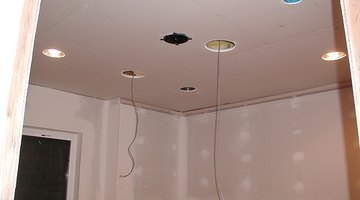Do It Yourself Basement Ceiling
Prior to finishing your basement's walls and floors, finishing your basement's ceilings will help to create that warm and cozy basement space you want for your home.

Prior to finishing your basement's walls and floors, finishing your basement's ceilings will help to create that warm and cozy basement space you want for your home. While many homeowners may choose to leave the ceiling beams exposed in their basements--even using the space between the beams for overhead storage--the finished, seamless look of a finished basement ceiling will make your basement space inviting to family and friends.
Insulation
Follow the local building codes for materials used in your basement. Make your basement's ceiling fireproof by installing fireproof insulation between the ceiling beams. The insulation will act as a fire barrier to protect the basement from a fire started on the main floor and a protection for the rest of the house against a fire originating in the basement.
The insulation will conserve heat in the winter and cold in the summer. If your basement will be used as additional living space, the insulation will also add a sound barrier between the two levels.
First vacuum away any collected dust or dirt between the ceiling beams and have your ceiling inspected for its structural integrity--no termites, water damage or cracks. Also have your plumbing and electrical inspected for safety codes so that you will not have to worry about water leakage or electrical problems after your ceiling is installed.
Wear protective clothing, gloves, goggles and a facemask when handling the insulation. The particles are not safe to breathe in or to come in contact with your skin. The insulation is fitted between the ceiling beams and tacked or stapled into place. Continue to fill in all of the spaces, leaving no gaps for air to flow through.
Drywall
Drywall is a structurally sound and permanent way to finish a basement ceiling. It will seal out the dust from the insulation, and it will prevent open pockets for airflow, mold and airborne allergens to breed and collect.
Your local building code may require drywall of at least 5/8 inches thick to create a fire barrier. In combination with fireproof insulation, your basement ceiling will likely hold back a fire long enough for everyone to leave the house.
If you intend to install full sheets of drywall at a time, you will need a few extra hands to support its weight and to prevent it from breaking. Mark your beams for the screws and screw in a few support drywall screws around the perimeter and in the middle. Then go back and add the rest of the screws, evenly spaced about 12 inches apart.
Continue adding drywall to the ceiling, lining up the seams and making necessary cuts to fit the pieces into tight spaces. When you meet lighting or plumbing fixtures that require cutouts, measure the distance on the ceiling lengthwise and widthwise for the hole. Transfer to the drywall, and cut out with a drywall knife. Line up the drywall to the ceiling to check your cut before attaching it. Make any cut adjustments and then screw into place.
Tape and Spackle
Use drywall tape and spackle to conceal the seams between the pieces of drywall. Apply a layer of spackle or joint compound directly on the seam, then add the drywall tape over it. Use a drywall knife to smooth it flush with the drywall, and then add another layer of spackle on top. Smooth again, feathering the joint compound with a feathering knife, and let dry.
Continue to seal the seams and cover the screw holes until your basement ceiling is smooth. Once the ceiling is dry add another layer of joint compound, let it dry and then lightly sand away any uneven areas.
Paint
Once your ceiling is complete, install your basement walls if they were not already done. Choose a color to complement your basement's purpose and paint both the ceiling and the walls. You may even choose to use a waterproofing paint or mold and mildew-resistant paint to add extra protection from moisture in your basement.
References
Writer Bio
Naima Manal's articles on health, diet, nutrition, alternative medicine, education, parenting, crafts, travel, home and garden and home improvement have appeared on various websites. Manal received her Bachelor of Science in biology/pre-medical studies from Molloy College in 1994 and has been a freelance writer, teacher and homeschooling mom since 1993.
More Articles



